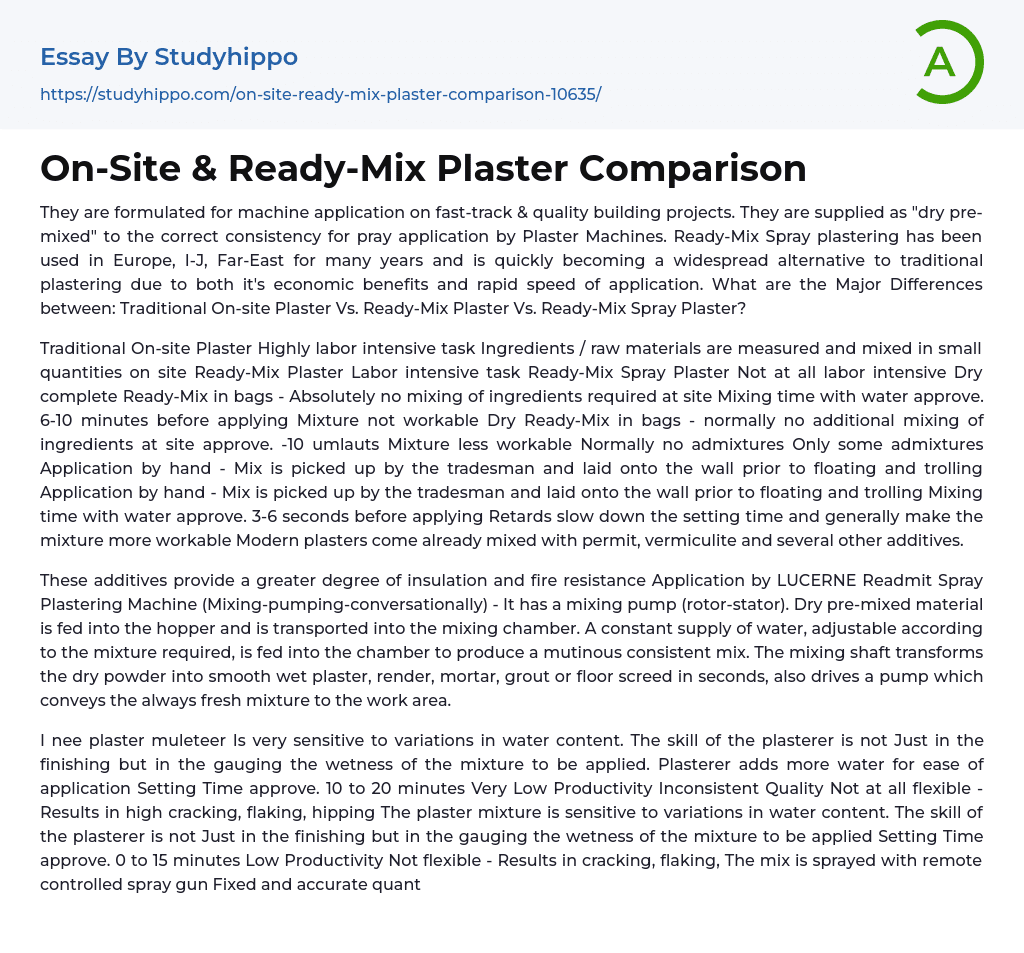Ready-Mix Spray plastering is a fast and high-quality building method supplied as "dry pre-mixed" for spray application by Plaster Machines. This technique has been widely used in Europe, UK, and the Far East for many years due to its economic benefits and quick application speed. The main differences between Traditional On-site Plaster, Ready-Mix Plaster, and Ready-Mix Spray Plaster are as follows:
Traditional On-site Plaster: This method involves labor-intensive tasks where ingredients/raw materials are measured and mixed on-site.
Ready-Mix Plaster: Similar to traditional on-site plastering, this method also requires labor-intensive tasks.
Ready-Mix Spray Plaster: In contrast to previous methods, this technique is not labor-intensive at all. The dry ready-mix comes in bags with no need for on-site ingredient mixing. It only requires 6-10 minutes of water mixing before applying. Although t
...he mixture is not workable, it still offers convenience compared to other methods.
In terms of composition, traditional plasters require additional on-site ingredient mixing while ready-mix plasters usually do not (unless specified). Additionally, ready-mixed plasters may include admixtures if necessary.
Both traditional and ready-mixed plasters can be applied by hand, but with ready-mixed spray plastering, the mixture is directly applied to the wall before floating and troweling. Modern plasters now come pre-mixed with additives such as permit and vermiculite, which improve insulation and fire resistance. The LUCERNE Readmit Spray Plastering Machine uses a mixing pump (rotor-stator) to apply the dry pre-mixed material. The material is placed in a hopper and transported to a mixing chamber where water is continuously supplied to create a consistent mix based on desired ratios. The mixing shaft quickly transforms the dry powder into wet plaster, render, mortar, grout or floo
screed while also driving a pump that delivers the fresh mixture to the work area. It is important for the plasterer to accurately gauge the wetness of the mixture by adding additional water if necessary. If not done correctly, issues such as high cracking, flaking, and shipping may occur due to inconsistencies in water content. However, with this machine's remote-controlled spray gun and fixed amount of water added to the ready-mix, these problems are minimized as it ensures independent control over wetness regardless of the plasterer's actions. The setting time for this process typically ranges from 8-15 minutes.
This method is highly efficient and productive, resulting in consistent high quality and reduced vulnerability to cracking, chipping, and flaking. There are two main types of ready-mix spray plasters: gypsum-based and cement-based. Gypsum-based plasters are suitable only for indoor use as they can crumble when exposed to dampness. On the other hand, cement-based plasters are primarily used for outdoor rendering but can also be utilized indoors for areas prone to dampness or requiring greater thickness.
Ready-mix spray plasters offer three finishes: standard smooth finish, fine textured finish, and coarse textured finish. For the standard smooth finish, the plaster is manually smoothed over using large spatulas or butterfly trowels after spray plastering. The fine textured finish involves leaving the sprayed plaster as it is to achieve a textured appearance. Similarly, in the coarse textured finish, the sprayed plaster is troweled to create a textured look.
The Ready-Mix Spray Plaster range includes two product ranges: Base Plaster and Finish Plaster. The Base Plaster serves as a filler and leveling compound that fills cracks, holes, and uneven surfaces in thin joint brick/block systems,
in-situ concrete with irregularities, and refurbishment projects. It should be applied 5-10 mm thick in one application with recommended 1-2 coats and drying time of 12-24 hours between applications.
Lucerne Ready-Mix Plaster Machines are used for its application.Finish Plaster can be applied in two ways: as a 1-2 mm thick top coat on Base Plaster or as a 2 coat finish directly on smooth backgrounds. It is versatile and can be used on pre-cast panels, composite boards, or over previously decorated surfaces. To apply this type of plaster, contractors use Lucerne Ready-Mix Plaster Machines. The coverage of Ready-Mix Spray Plaster is not specified.
Using this method offers consistent high quality which reduces the need for corrections and hacking off, ultimately minimizing rectification costs. Additionally, it speeds up construction progress and decreases the risk of material damage on site, resulting in cost reduction.
Contractors also benefit from using a machine because they can remove scaffolding earlier, reduce waste at the job site, and minimize maintenance expenses. However, the primary advantage lies in its ability to accurately track materials usage.
- Arch essays
- Area essays
- Auction essays
- Balanced Scorecard essays
- Business Plans essays
- Expense essays
- Income essays
- Net Income essays
- Security Guard essays
- Singapore Airlines essays
- Battle essays
- Intranet essays
- Maintenance essays
- Simulation essays
- Inn essays
- Chief Executive Officer essays
- Convenience Store essays
- Firm essays
- Training And Development essays
- Unilever essays
- Variable Cost essays
- Virgin Group essays
- Bargaining essays
- Entity essays
- Pest analysis essays
- Organic Chemistry essays
- Acid essays
- Calcium essays
- Chemical Bond essays
- Chemical Reaction essays
- Chromatography essays
- Ethanol essays
- Hydrogen essays
- Periodic Table essays
- Titration essays
- Chemical reactions essays
- Osmosis essays
- Carbohydrate essays
- Carbon essays
- Ph essays
- Diffusion essays
- Copper essays
- Salt essays
- Concentration essays
- Sodium essays
- Distillation essays
- Amylase essays
- Magnesium essays
- Acid Rain essays
- Building essays




